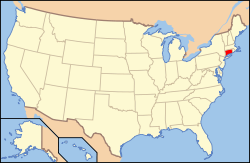| Wine region | |
 | |
| Official name | State of Connecticut |
|---|---|
| Type | U.S. state |
| Year established | 1788 |
| Country | United States |
| Sub-regions | Southeastern New England AVA, Western Connecticut Highlands AVA, Eastern Connecticut Highlands AVA |
| Climate region | Continental |
| Total area | 5,543 square miles (14,356 km2)[1] |
| Grapes produced | Aurore, Cabernet Franc, Cabernet Sauvignon, Cayuga, Chambourcin, Chardonel, Chardonnay, Frontenac, Gewurztraminer, Marechal Foch, Merlot, Pinot gris, Riesling, Seyval blanc, St. Croix, Vidal blanc, Vignoles[2] |
| No. of wineries | 25[3] |
Connecticut wine refers to wine made from grapes and other fruit grown in the U.S. state of Connecticut. The modern wine industry in Connecticut began with the passage of the Connecticut Winery Act in 1978. The wineries in Connecticut are located throughout the state, including in the three designated American Viticultural Areas in the state. The climate in the coastal region near Long Island Sound and the Connecticut River valley tends to be warmer than the highlands in the eastern and western sides of the state.[2]
- ^ "Connecticut Wine Region". Wine Searcher. Retrieved May 8, 2021.
- ^ a b "Connecticut: Appellation Profile". Appellation America. Archived from the original on September 3, 2013.
- ^ "Wineries & Vineyards". Connecticut (CT) Wine Trail. Retrieved May 8, 2021.